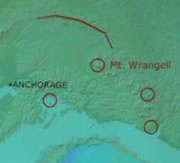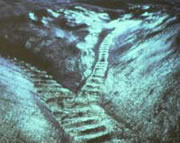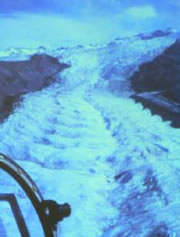 |
AAPT Winter Meeting 2006 |
 |
Probing the Ice Cap of Mt. Wrangell
Monday, Jan 23, 2006 9:30 - 10:00 AM Daniel Solie, University of Alaska Fairbanks
Mt. Wrangell is North America's largest active volcano, standing 14,000' tall. It is known as Ik'eledi (Smoking Top) in Ahtna. From 1953-54 it was home to a cosmic ray observatory. The dry snow preserves climate records. It is home to pulsating streams, and ogives (standing waves in ice).
The caldera depth was not known. To measure the depth, VLF waves are created and reflected from the ionosphere. The ionosphere pulsates and acts as a radiation source. By measuring the electric field, the magnetic field, and the phase angle of this radiation at points along the caldera surface, it is possible to calculate the ice depth, since the depth affects the resistance of the ice.
The HAARP-generated radiation sent to the ionosphere comes from 180 antennas (formerly 48) that broadcast a peak of 960 kW in a cone of radiation varying from 4º to 9º, and at frequencies ranging from 3 MHz to 10 MHz. The new array will be tried this summer. Scientists need to know the depth of the caldera in order to determine its water content, in case of future eruptions.



